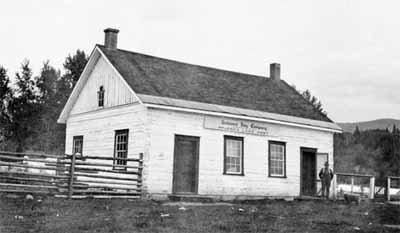Fort McLeod National Historic Site of Canada
McLeod Lake, British Columbia

Side view of a post at Fort McLeod.
© Department of Mines and Technical Surveys, Natural Resources Canada | ministère des Mines et des Relevés Technique, Ressources naturelles Canada, 1929
Address :
McLeod Lake, British Columbia
Recognition Statute:
Historic Sites and Monuments Act (R.S.C., 1985, c. H-4)
Designation Date:
1953-05-26
Dates:
-
1805 to 1805
(Construction)
-
1805 to 1821
(Significant)
-
1805 to 1826
(Significant)
-
1821 to 1935
(Significant)
Event, Person, Organization:
-
Simon Fraser
(Person)
-
Archibald Norman McLeod
(Person)
-
Hudson's Bay Company
(Organization)
-
North West Company
(Organization)
-
Sekani Tribe
(Organization)
Other Name(s):
-
Fort McLeod
(Designation Name)
-
McLeod Lake
(Other Name)
-
Trout Lake Post
(Other Name)
-
McLeod's Lake
(Other Name)
Research Report Number:
2009-CED-SDC-036
Plaque(s)
Existing plaque: McLeod Lake, British Columbia
In its search for unexploited fur resources the North West Company sent an expedition west of the Rockies to McLeod Lake in the spring of 1805. That fall Simon Fraser built Fort McLeod, the Nor’Westers’ first post in New Caledonia, as a base for extending operations west of the mountains. The post was designed to trade with the Sekani and to supply parties using the Peace River route to Athabasca. After 1821 the Hudson’s Bay Company retained Fort McLeod, which it kept open into the 20th century. It is now the site of the modern community of McLeod Lake.
Description of Historic Place
Fort McLeod National Historic Site of Canada is located on the west bank of Pack River at the north end of McLeod Lake, British Columbia. The site, set in the provincial heritage site, Fort McLeod Historic Park, consists of a workshop, a house, and a warehouse, which are situated within the fenced area of the fort. The small wooden buildings are topped with gable roof, and are simply constructed. Official recognition refers to the fenced area around the fort at the time of designation.
Heritage Value
Fort McLeod was designated as a National Historic Site of Canada in 1953. It is recognized because: founded in 1805, it was the site of the first fur-trading post built by the North West Company west of the Rocky Mountains; Indigenous Peoples, their territories, and labour were foundational to the fur trade in North America. Posts were often built near existing Indigenous settlements, trading routes and/or meeting places and became important sites of economic, social and cultural exchange.
By the early 19th century, the fur trade was expanding westward over the Rocky Mountains to the Pacific Ocean, and the North West Company found itself increasingly threatened by the Hudson’s Bay Company and American fur traders. As a result, in 1805, Simon Fraser of the North West Company led an expedition westward from Fort William on Lake Superior to secure the fur trade for the company on the west side of the Rocky Mountains. This newly discovered area was named New Caledonia.
Fraser sent a group of men up the Pack River to build a stockaded log fort at Trout Lake, which was later named Fort McLeod in honour of Archibald Norman, a senior North West Company partner. Fort McLeod became the base of the company’s fur trading operations in New Caledonia, and was the only liaison between the two sides of the Rocky Mountains for two decades. After the amalgamation of the North West and Hudson’s Bay companies in 1821, the fort remained an active trading post into the 20th century.
Sources: Historic Sites and Monuments Board of Canada, Minutes, 1953, 1954, 1977, 2009, December 2020.
Character-Defining Elements
Key elements that contribute to the heritage character of the site include: its location on the west bank of the Pack River at the north end of McLeod Lake, British Columbia; the small, rectangular massing of the buildings, clad with wood siding and topped with gable roof; the simple, unadorned façades, pierced with multiple windows; the integrity of any surviving or as yet unidentified archaeological remains which may be found within the site in their original placement and extent; viewscapes from the site across Pack River.